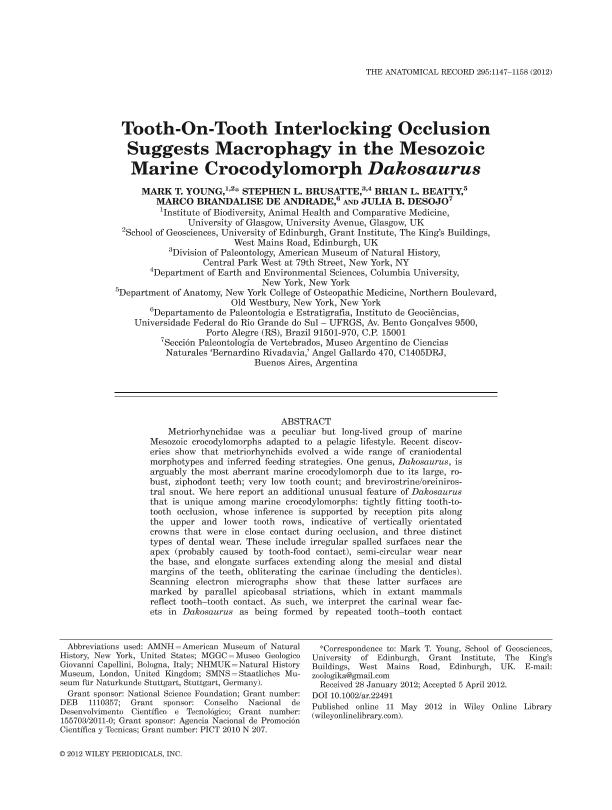Mostrar el registro sencillo del ítem
dc.contributor.author
Young, Mark T.
dc.contributor.author
Brusatte, Stephen L.
dc.contributor.author
Beatty, Brian L.
dc.contributor.author
Brandalise de Andrade, Marco

dc.contributor.author
Desojo, Julia Brenda

dc.date.available
2019-01-10T15:12:12Z
dc.date.issued
2012-07
dc.identifier.citation
Young, Mark T.; Brusatte, Stephen L.; Beatty, Brian L.; Brandalise de Andrade, Marco; Desojo, Julia Brenda; Tooth-On-Tooth Interlocking Occlusion Suggests Macrophagy in the Mesozoic Marine Crocodylomorph Dakosaurus; Wiley-liss, Div John Wiley & Sons Inc; Anatomical Record-Advances in Integrative Anatomy and Evolutionary Biology; 295; 7; 7-2012; 1147-1158
dc.identifier.issn
1932-8486
dc.identifier.uri
http://hdl.handle.net/11336/67886
dc.description.abstract
Metriorhynchidae was a peculiar but long-lived group of marine Mesozoic crocodylomorphs adapted to a pelagic lifestyle. Recent discoveries show that metriorhynchids evolved a wide range of craniodental morphotypes and inferred feeding strategies. One genus, Dakosaurus, is arguably the most aberrant marine crocodylomorph due to its large, robust, ziphodont teeth; very low tooth count; and brevirostrine/oreinirostral snout. We here report an additional unusual feature of Dakosaurus that is unique among marine crocodylomorphs: tightly fitting tooth-to-tooth occlusion, whose inference is supported by reception pits along the upper and lower tooth rows, indicative of vertically orientated crowns that were in close contact during occlusion, and three distinct types of dental wear. These include irregular spalled surfaces near the apex (probably caused by tooth-food contact), semi-circular wear near the base, and elongate surfaces extending along the mesial and distal margins of the teeth, obliterating the carinae (including the denticles). Scanning electron micrographs show that these latter surfaces are marked by parallel apicobasal striations, which in extant mammals reflect tooth-tooth contact. As such, we interpret the carinal wear facets in Dakosaurus as being formed by repeated tooth-tooth contact between the mesial and distal margins of the teeth of the upper and lower jaw. We posit that this increased the available shearing surface on their high crowns. Together, these wear patterns suggest that occlusion in Dakosaurus was specialized for cutting large and abrasive prey items into portions small enough to swallow, making it a prime example of an aquatic reptile with macrophagous feeding habits. © 2012 Wiley-Periodicals, Inc.
dc.format
application/pdf
dc.language.iso
eng
dc.publisher
Wiley-liss, Div John Wiley & Sons Inc

dc.rights
info:eu-repo/semantics/openAccess
dc.rights.uri
https://creativecommons.org/licenses/by-nc-sa/2.5/ar/
dc.subject
Feeding
dc.subject
Functional Ecology
dc.subject
Metriorhynchidae
dc.subject
Occlusion
dc.subject
Thalattosuchia
dc.title
Tooth-On-Tooth Interlocking Occlusion Suggests Macrophagy in the Mesozoic Marine Crocodylomorph Dakosaurus
dc.type
info:eu-repo/semantics/article
dc.type
info:ar-repo/semantics/artículo
dc.type
info:eu-repo/semantics/publishedVersion
dc.date.updated
2019-01-09T17:46:47Z
dc.journal.volume
295
dc.journal.number
7
dc.journal.pagination
1147-1158
dc.journal.pais
Estados Unidos

dc.journal.ciudad
Nueva York
dc.description.fil
Fil: Young, Mark T.. University of Glasgow; Reino Unido. University of Edinburgh; Reino Unido
dc.description.fil
Fil: Brusatte, Stephen L.. Columbia University In The City Of New York; . American Museum of Natural History; Estados Unidos
dc.description.fil
Fil: Beatty, Brian L.. New York College Of Osteopathic Medicine, Old Westbury;
dc.description.fil
Fil: Brandalise de Andrade, Marco. Universidade Federal do Rio Grande do Sul; Brasil
dc.description.fil
Fil: Desojo, Julia Brenda. Consejo Nacional de Investigaciones Científicas y Técnicas. Oficina de Coordinación Administrativa Parque Centenario. Museo Argentino de Ciencias Naturales “Bernardino Rivadavia”; Argentina
dc.journal.title
Anatomical Record-Advances in Integrative Anatomy and Evolutionary Biology

dc.relation.alternativeid
info:eu-repo/semantics/altIdentifier/doi/https://dx.doi.org/10.1002/ar.22491
dc.relation.alternativeid
info:eu-repo/semantics/altIdentifier/url/https://onlinelibrary.wiley.com/doi/10.1002/ar.22491
Archivos asociados
